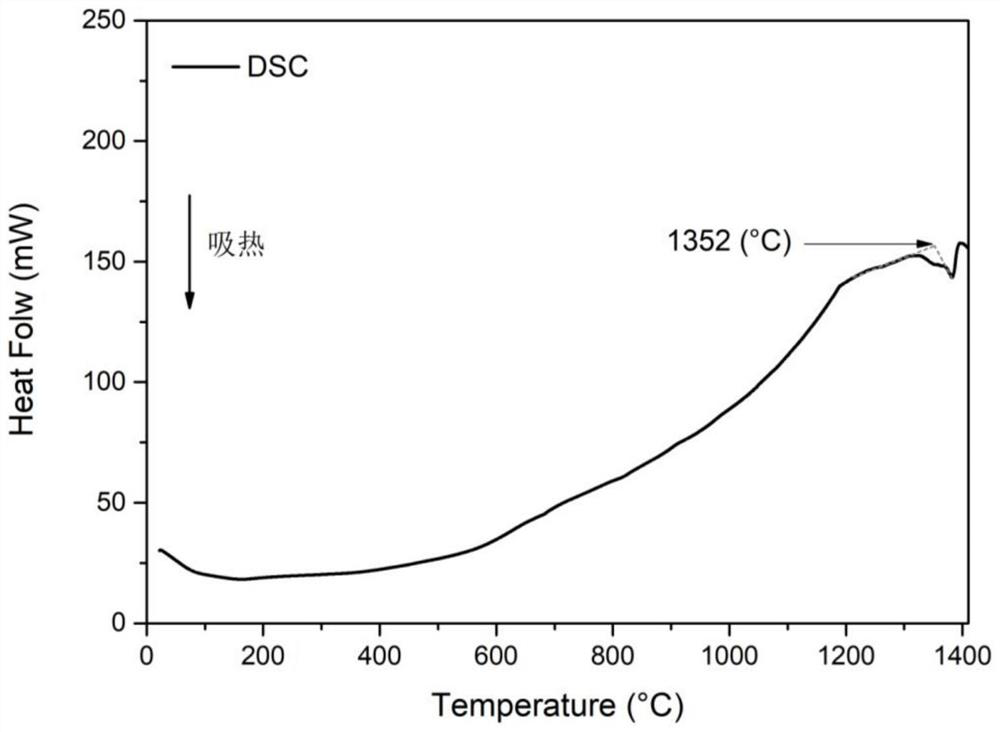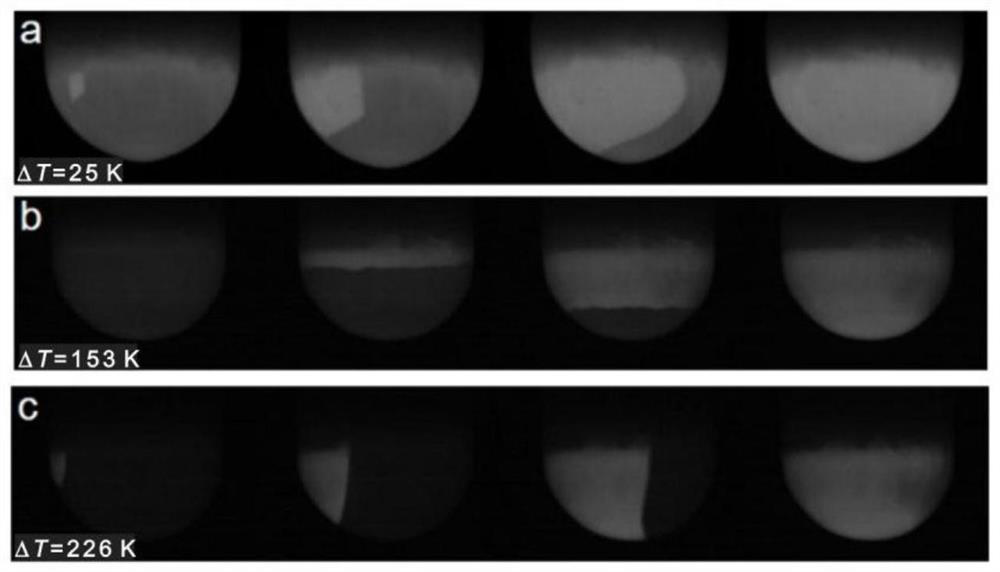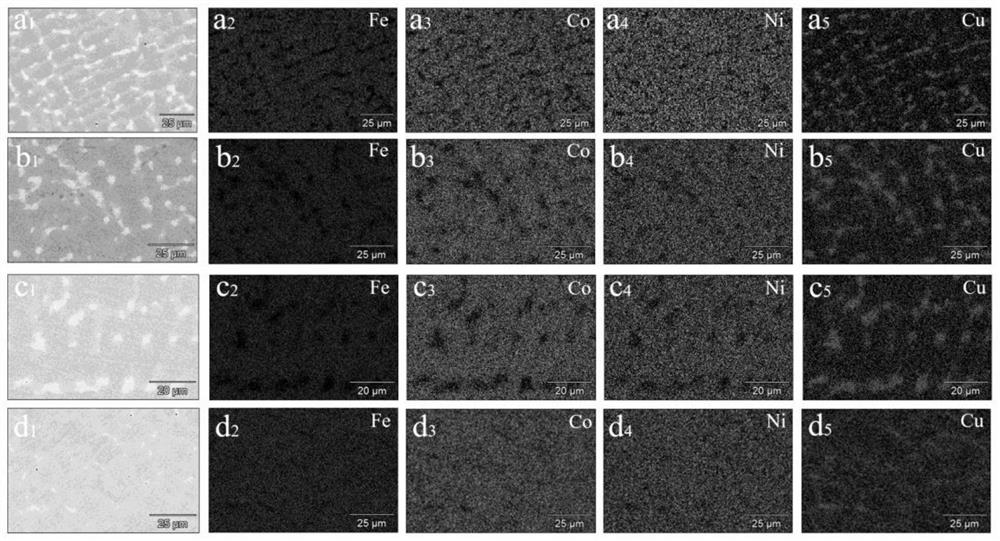Method for improving microstructure uniformity and frictional wear performance of Cu-containing multi-principal-element alloy
A multi-principal alloy, friction and wear technology is applied in the field of improving the microstructure uniformity and friction and wear performance of Cu-containing multi-principal alloys, which can solve the problems of poor friction and wear properties of Cu-containing multi-principal alloys, and achieve low production costs. , The effect of solidification speed realization and wear rate reduction
- Summary
- Abstract
- Description
- Claims
- Application Information
AI Technical Summary
Problems solved by technology
Method used
Image
Examples
Embodiment 1
[0063] Preparation of a Cu-containing multi-principal alloy sample with a slow solidification rate. Example 1 The initial composition of the alloy is an ingot of FeCoNiCu master alloy with uniform macrostructure, which is first cut into 3-5g alloy pieces.
[0064] In order to facilitate the production of mechanical test samples, weigh not less than 20g of the as-cast master alloy small pieces prepared in the comparative example, put them into a quartz glass crucible with an outer diameter of 22mm and a wall thickness of 1.5mm, and place them on the upper and lower surfaces of the metal Put some boron oxide (B 2 o 3 ) Purifying agent, place the quartz glass crucible in the high-frequency induction coil of the induction melting furnace chamber.
[0065] First vacuum to 1*10 -3 Pa, filled with high-purity Ar gas to 5*10 -2 MPa scrubbing. Then vacuum the second time to 1*10 -3 Pa, then filled with high-purity Ar gas to 5*10 -2 MPa.
[0066] Turn on the high-frequency induct...
Embodiment 2
[0076] Preparation of a Cu-containing multi-principal alloy sample with an intermediate supercooling solidification rate. The initial composition of the alloy in Example 2 is a FeCoNiCu master alloy ingot with uniform structure, which is first cut into 3-5g alloy pieces.
[0077] Weigh not less than 20g of the as-cast master alloy fritter that comparative example makes, it is put into the quartz glass crucible that outer diameter is 22mm, and wall thickness is 1.5mm, and puts some boron oxide (B 2 o 3 ) Purifying agent, place the quartz glass crucible in the high-frequency induction coil of the chamber.
[0078] First vacuum to 1*10 -3 Pa, filled with high-purity Ar gas to 5*10 -2 MPa scrubbing. Then vacuum the second time to 1*10 -3 Pa, then filled with high-purity Ar gas to 5*10 -2 MPa.
[0079] Turn on the high-frequency induction heating power supply, and use the induction coil wound by copper tube to heat the sample to a temperature higher than B 2 o 3 The melting p...
Embodiment 3
[0089] Preparation of a Cu-containing multi-principal alloy sample with a fast solidification speed. The initial composition of the alloy in Example 3 is a FeCoNiCu master alloy ingot with a uniform macrostructure, which is first cut into 3-5g alloy pieces.
[0090] Weigh not less than 20g of the as-cast master alloy fritter that comparative example makes, it is put into the quartz glass crucible that outer diameter is 22mm, and wall thickness is 1.5mm, and puts some boron oxide (B 2 o 3 ) Purifying agent, place the quartz glass crucible in the high-frequency induction coil of the chamber.
[0091] First vacuum to 1*10 -3 Pa, filled with high-purity Ar gas to 5*10 -2 MPa scrubbing. Then vacuum the second time to 1*10 -3 Pa, then filled with high-purity Ar gas to 5*10 -2 MPa.
[0092] Turn on the high-frequency induction heating power supply, and use the induction coil wound by copper tube to heat the sample to a temperature higher than B 2 o 3 The melting point of but ...
PUM
| Property | Measurement | Unit |
|---|---|---|
| melting point | aaaaa | aaaaa |
| friction coefficient | aaaaa | aaaaa |
| dispersion coefficient | aaaaa | aaaaa |
Abstract
Description
Claims
Application Information
 Login to View More
Login to View More - R&D
- Intellectual Property
- Life Sciences
- Materials
- Tech Scout
- Unparalleled Data Quality
- Higher Quality Content
- 60% Fewer Hallucinations
Browse by: Latest US Patents, China's latest patents, Technical Efficacy Thesaurus, Application Domain, Technology Topic, Popular Technical Reports.
© 2025 PatSnap. All rights reserved.Legal|Privacy policy|Modern Slavery Act Transparency Statement|Sitemap|About US| Contact US: help@patsnap.com



